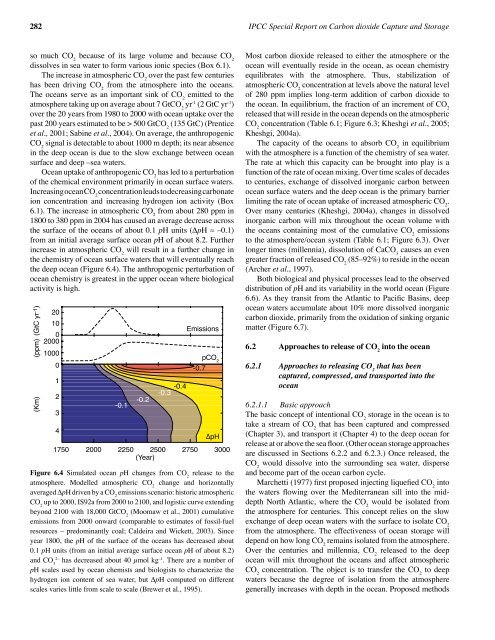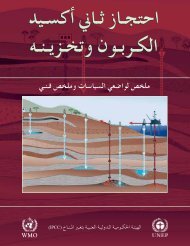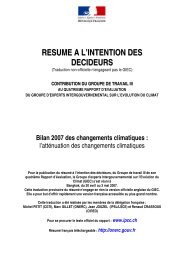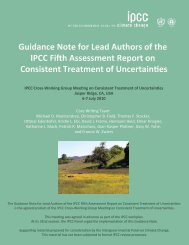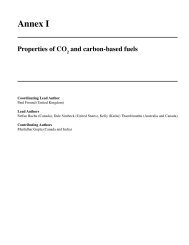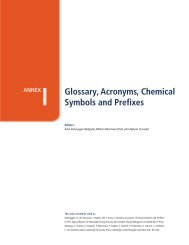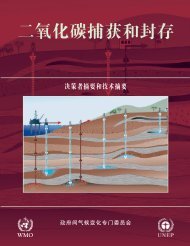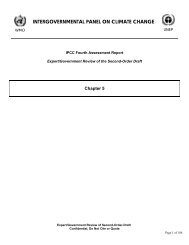Intergovernmental Panel on Climate Change (IPCC ... - ipcc-wg3
Intergovernmental Panel on Climate Change (IPCC ... - ipcc-wg3
Intergovernmental Panel on Climate Change (IPCC ... - ipcc-wg3
Create successful ePaper yourself
Turn your PDF publications into a flip-book with our unique Google optimized e-Paper software.
282 <strong>IPCC</strong> Special Report <strong>on</strong> Carb<strong>on</strong> dioxide Capture and Storage<br />
so much CO 2<br />
because of its large volume and because CO 2<br />
dissolves in sea water to form various i<strong>on</strong>ic species (Box 6.1).<br />
The increase in atmospheric CO 2<br />
over the past few centuries<br />
has been driving CO 2<br />
from the atmosphere into the oceans.<br />
The oceans serve as an important sink of CO 2<br />
emitted to the<br />
atmosphere taking up <strong>on</strong> average about 7 GtCO 2<br />
yr -1 (2 GtC yr -1 )<br />
over the 20 years from 1980 to 2000 with ocean uptake over the<br />
past 200 years estimated to be > 500 GtCO 2<br />
(135 GtC) (Prentice<br />
et al., 2001; Sabine et al., 2004). On average, the anthropogenic<br />
CO 2<br />
signal is detectable to about 1000 m depth; its near absence<br />
in the deep ocean is due to the slow exchange between ocean<br />
surface and deep –sea waters.<br />
Ocean uptake of anthropogenic CO 2<br />
has led to a perturbati<strong>on</strong><br />
of the chemical envir<strong>on</strong>ment primarily in ocean surface waters.<br />
Increasing ocean CO 2<br />
c<strong>on</strong>centrati<strong>on</strong> leads to decreasing carb<strong>on</strong>ate<br />
i<strong>on</strong> c<strong>on</strong>centrati<strong>on</strong> and increasing hydrogen i<strong>on</strong> activity (Box<br />
6.1). The increase in atmospheric CO 2<br />
from about 280 ppm in<br />
1800 to 380 ppm in 2004 has caused an average decrease across<br />
the surface of the oceans of about 0.1 pH units (∆pH ≈ –0.1)<br />
from an initial average surface ocean pH of about 8.2. Further<br />
increase in atmospheric CO 2<br />
will result in a further change in<br />
the chemistry of ocean surface waters that will eventually reach<br />
the deep ocean (Figure 6.4). The anthropogenic perturbati<strong>on</strong> of<br />
ocean chemistry is greatest in the upper ocean where biological<br />
activity is high.<br />
Most carb<strong>on</strong> dioxide released to either the atmosphere or the<br />
ocean will eventually reside in the ocean, as ocean chemistry<br />
equilibrates with the atmosphere. Thus, stabilizati<strong>on</strong> of<br />
atmospheric CO 2<br />
c<strong>on</strong>centrati<strong>on</strong> at levels above the natural level<br />
of 280 ppm implies l<strong>on</strong>g-term additi<strong>on</strong> of carb<strong>on</strong> dioxide to<br />
the ocean. In equilibrium, the fracti<strong>on</strong> of an increment of CO 2<br />
released that will reside in the ocean depends <strong>on</strong> the atmospheric<br />
CO 2<br />
c<strong>on</strong>centrati<strong>on</strong> (Table 6.1; Figure 6.3; Kheshgi et al., 2005;<br />
Kheshgi, 2004a).<br />
The capacity of the oceans to absorb CO 2<br />
in equilibrium<br />
with the atmosphere is a functi<strong>on</strong> of the chemistry of sea water.<br />
The rate at which this capacity can be brought into play is a<br />
functi<strong>on</strong> of the rate of ocean mixing. Over time scales of decades<br />
to centuries, exchange of dissolved inorganic carb<strong>on</strong> between<br />
ocean surface waters and the deep ocean is the primary barrier<br />
limiting the rate of ocean uptake of increased atmospheric CO 2<br />
.<br />
Over many centuries (Kheshgi, 2004a), changes in dissolved<br />
inorganic carb<strong>on</strong> will mix throughout the ocean volume with<br />
the oceans c<strong>on</strong>taining most of the cumulative CO 2<br />
emissi<strong>on</strong>s<br />
to the atmosphere/ocean system (Table 6.1; Figure 6.3). Over<br />
l<strong>on</strong>ger times (millennia), dissoluti<strong>on</strong> of CaCO 3<br />
causes an even<br />
greater fracti<strong>on</strong> of released CO 2<br />
(85–92%) to reside in the ocean<br />
(Archer et al., 1997).<br />
Both biological and physical processes lead to the observed<br />
distributi<strong>on</strong> of pH and its variability in the world ocean (Figure<br />
6.6). As they transit from the Atlantic to Pacific Basins, deep<br />
ocean waters accumulate about 10% more dissolved inorganic<br />
carb<strong>on</strong> dioxide, primarily from the oxidati<strong>on</strong> of sinking organic<br />
matter (Figure 6.7).<br />
6.2 Approaches to release of CO 2<br />
into the ocean<br />
6.2.1 Approaches to releasing CO 2<br />
that has been<br />
captured, compressed, and transported into the<br />
ocean<br />
Figure 6.4 Simulated ocean pH changes from CO 2<br />
release to the<br />
atmosphere. Modelled atmospheric CO 2<br />
change and horiz<strong>on</strong>tally<br />
averaged ∆pH driven by a CO 2<br />
emissi<strong>on</strong>s scenario: historic atmospheric<br />
CO 2<br />
up to 2000, IS92a from 2000 to 2100, and logistic curve extending<br />
bey<strong>on</strong>d 2100 with 18,000 GtCO 2<br />
(Moomaw et al., 2001) cumulative<br />
emissi<strong>on</strong>s from 2000 <strong>on</strong>ward (comparable to estimates of fossil-fuel<br />
resources – predominantly coal; Caldeira and Wickett, 2003). Since<br />
year 1800, the pH of the surface of the oceans has decreased about<br />
0.1 pH units (from an initial average surface ocean pH of about 8.2)<br />
and CO 3<br />
2–<br />
has decreased about 40 µmol kg –1 . There are a number of<br />
pH scales used by ocean chemists and biologists to characterize the<br />
hydrogen i<strong>on</strong> c<strong>on</strong>tent of sea water, but ∆pH computed <strong>on</strong> different<br />
scales varies little from scale to scale (Brewer et al., 1995).<br />
6.2.1.1 Basic approach<br />
The basic c<strong>on</strong>cept of intenti<strong>on</strong>al CO 2<br />
storage in the ocean is to<br />
take a stream of CO 2<br />
that has been captured and compressed<br />
(Chapter 3), and transport it (Chapter 4) to the deep ocean for<br />
release at or above the sea floor. (Other ocean storage approaches<br />
are discussed in Secti<strong>on</strong>s 6.2.2 and 6.2.3.) Once released, the<br />
CO 2<br />
would dissolve into the surrounding sea water, disperse<br />
and become part of the ocean carb<strong>on</strong> cycle.<br />
Marchetti (1977) first proposed injecting liquefied CO 2<br />
into<br />
the waters flowing over the Mediterranean sill into the middepth<br />
North Atlantic, where the CO 2<br />
would be isolated from<br />
the atmosphere for centuries. This c<strong>on</strong>cept relies <strong>on</strong> the slow<br />
exchange of deep ocean waters with the surface to isolate CO 2<br />
from the atmosphere. The effectiveness of ocean storage will<br />
depend <strong>on</strong> how l<strong>on</strong>g CO 2<br />
remains isolated from the atmosphere.<br />
Over the centuries and millennia, CO 2<br />
released to the deep<br />
ocean will mix throughout the oceans and affect atmospheric<br />
CO 2<br />
c<strong>on</strong>centrati<strong>on</strong>. The object is to transfer the CO 2<br />
to deep<br />
waters because the degree of isolati<strong>on</strong> from the atmosphere<br />
generally increases with depth in the ocean. Proposed methods


